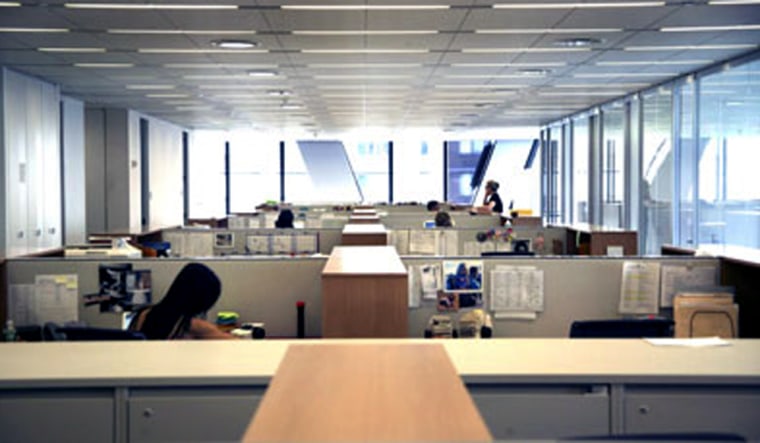It is 8 p.m. on a balmy summer evening, and Brooke Rosen is still at work. “I didn’t even notice it was that late,” says Rosen, an associate accessories editor at Cosmopolitan. “I didn’t feel like I was in lock-down.”
How could she? Cosmopolitan’s new offices are on the 38th floor of Hearst’s new, $500 million headquarters with floor-to-ceiling views of Central Park, the Manhattan skyline and the Hudson River. Its lobby’s waterfall recreates the sounds of a serene “babbling brook,” and a state of the art in-house gym also provides employees a place to unwind. Plus, it outfits them with fresh Nike and Reebok clothes to work out in.
Creating employee-friendly spaces isn’t exclusive to Hearst. In fact, it is just the latest company to buy into a larger trend of transforming run of the mill offices into stylish working environments. BP, Bloomberg and Fidelity Investments are among several firms that have already laid the foundation for highly designed headquarters.
The idea: Create comfortable places, and employees will work longer, harder and more profitably. “We absolutely believe it will positively affect the bottom line,” says Brian G. Schwagerl, director of real estate and facilities planning at Hearst. “It will pay off in ways beyond a pat on the back.”
The data support that hypothesis. Gensler, the design and strategic consulting firm that created Hearst’s interior, commissioned a survey last March that found that workplaces significantly affect employees’ productivity, creativity and attitudes about their work. Employees estimated they could increase the amount of work they do an average of 22% if they had a better-designed workplace, according to the survey.
It’s something the bosses already knew. Nearly 90 percent of C-suite executives and other senior staffers say that a better physical working environment would have a positive impact on their companies’ bottom lines. Employees agree, with 72 percent saying that a better physical working environment would have a positive impact on their company’s bottom line, according to the study.
So what constitutes good workplace design? The top three elements are temperature, lighting and noise, according to Michael Berens, director of research and knowledge resources at the American Society of Interior Designers.
But there’s no one answer to those three issues. When Diane Hoskins, executive director of Gensler, begins work with a new client, they meet to discuss specific needs. “One size does not fit all,” says Hoskins. “There’s no universal solution for every company. We have to start with the goals and objectives of organizations and culture and have to understand the work practices that make a company successful.”
Collaboration is the buzzword in workplace design. In fact, 67 percent of workers believe they are more efficient when they work closely with co-workers, according to the Gensler study. For most companies, that means taking down high, Dilbert-esque cubicles and replacing them with low-walled partitions that encourage interaction with employees. To that end, Gensler creates casual meeting areas where employees naturally pass each other in the halls.
At Hearst, that manifests itself on the second floor, where there is a gourmet cafeteria — Café 57 — with dozens of comfortable chairs and sofas. The company refers to it as its living room, and it’s a place for employees to meet. Desks at Cosmopolitan are outfitted with a pullout file cabinet that doubles as a stool for co-workers to sit on when they visit. There are also nooks at each end of the office, where there are tables meant for open meetings instead of those behind closed doors.
Another trend is designing green. There’s a push to use materials that are friendly to the environment, such as using bamboo instead of mahogany. “The idea is to not show things that are coming out of endangered forests,” says David Landy, of David Landy Interiors. “Mahogany is getting raped in the forests of South America and Africa.” Hearst uses recycled carpet and also expects to save on its energy bills because of the natural light.
Offices are about to get even more high-tech. Imagine a building that responds to employee behavior. That’s what Steven J. Orfield, president of Orfield Laboratories, a Minnesota-based company that focuses on the science of building design, is pitching to his clients. Architectural dynamics “envisions the office as an organic place that behaves in relation to its occupants,” Orfield says.
A computer system will modify lighting, temperature, smell and color based on its occupants' behavior. For instance, if many people are up and walking around, the computer will infer that people are uncomfortable or restless and readjust the surroundings. The system isn’t in place yet, but Orfield says it’s likely within the next year.
If redesigning the office sounds like a major investment, remember that well-designed workplaces can be a valuable recruiting and retention tool. Soon, workers won’t sit still for a simple desk lamp or fan.
